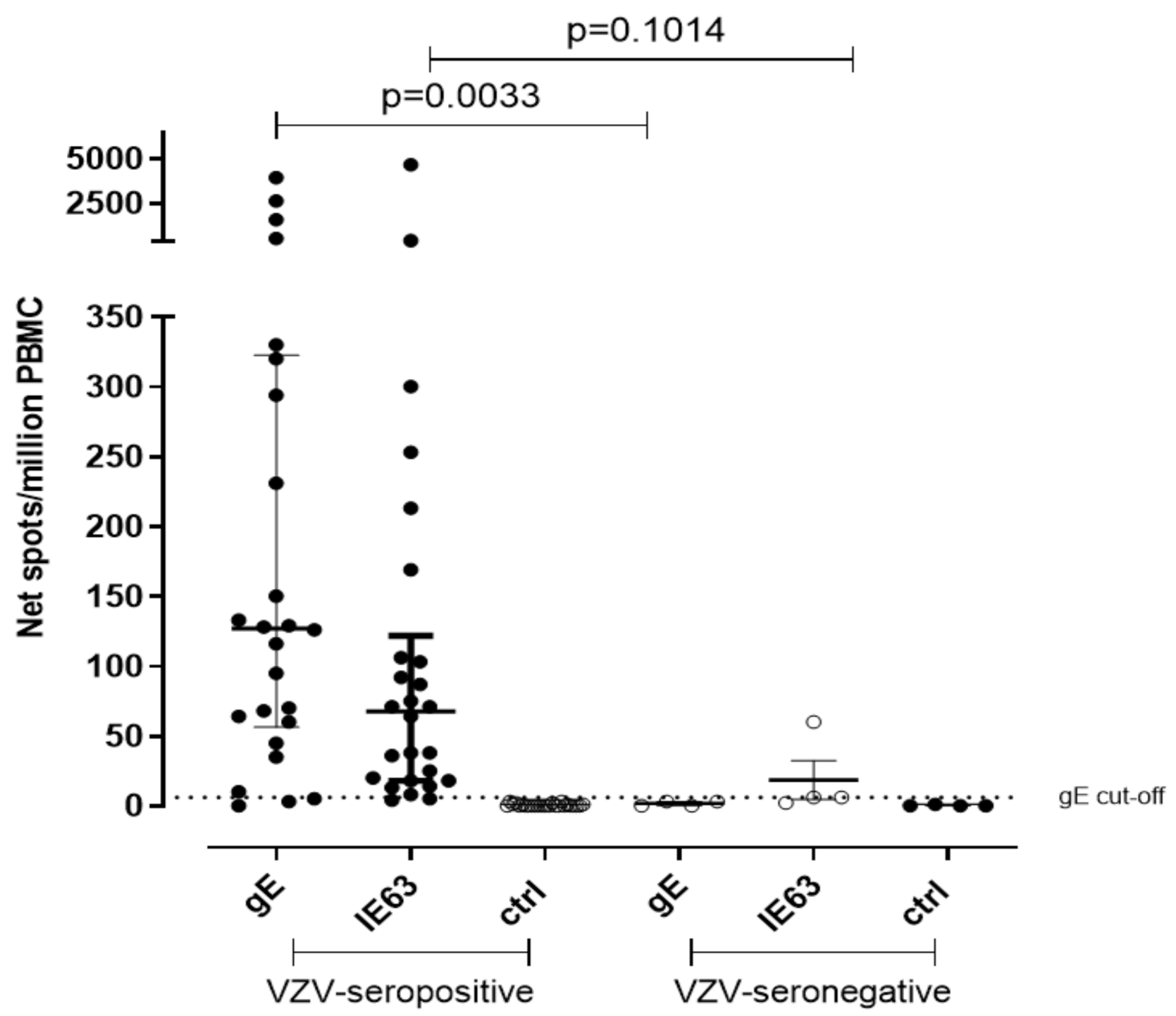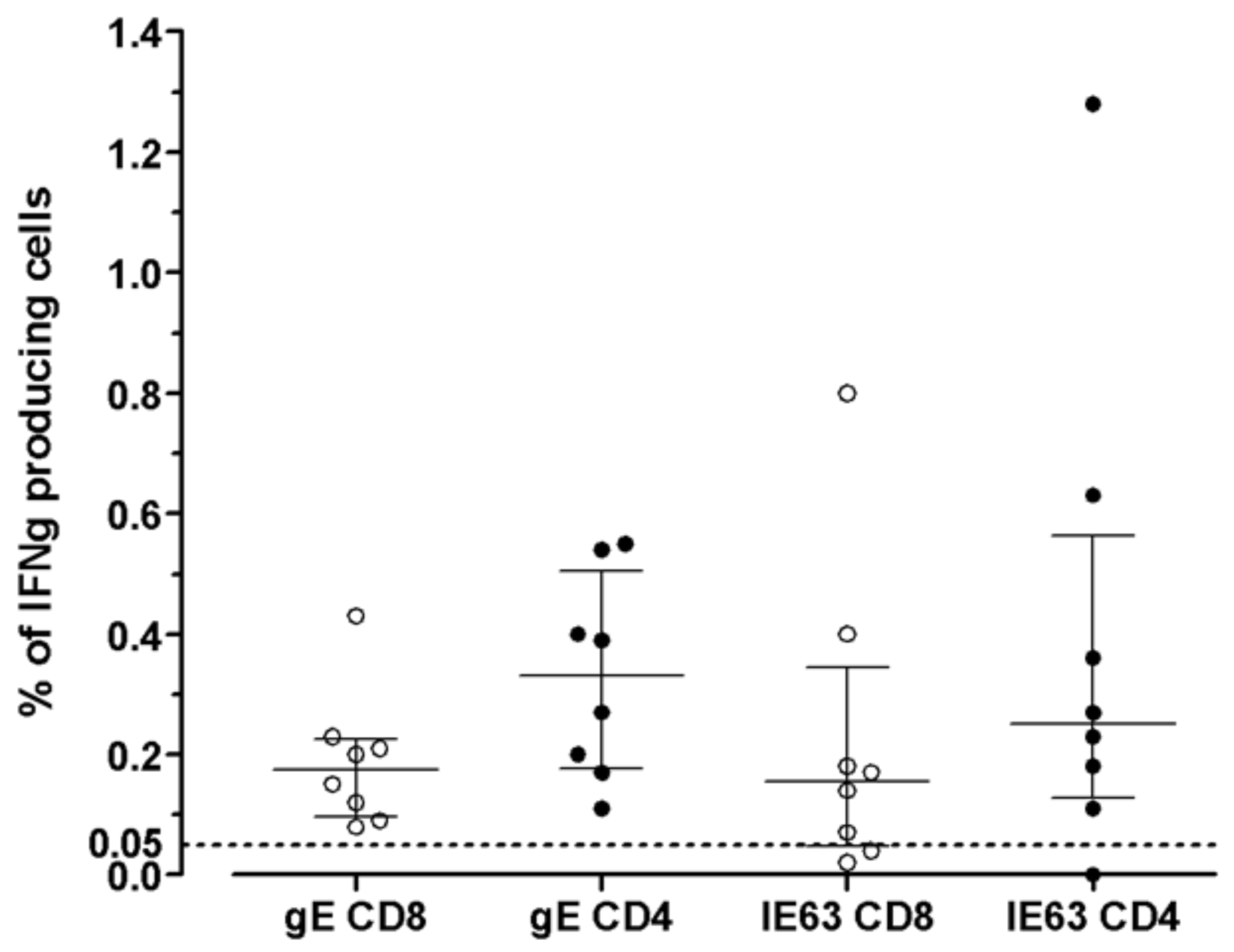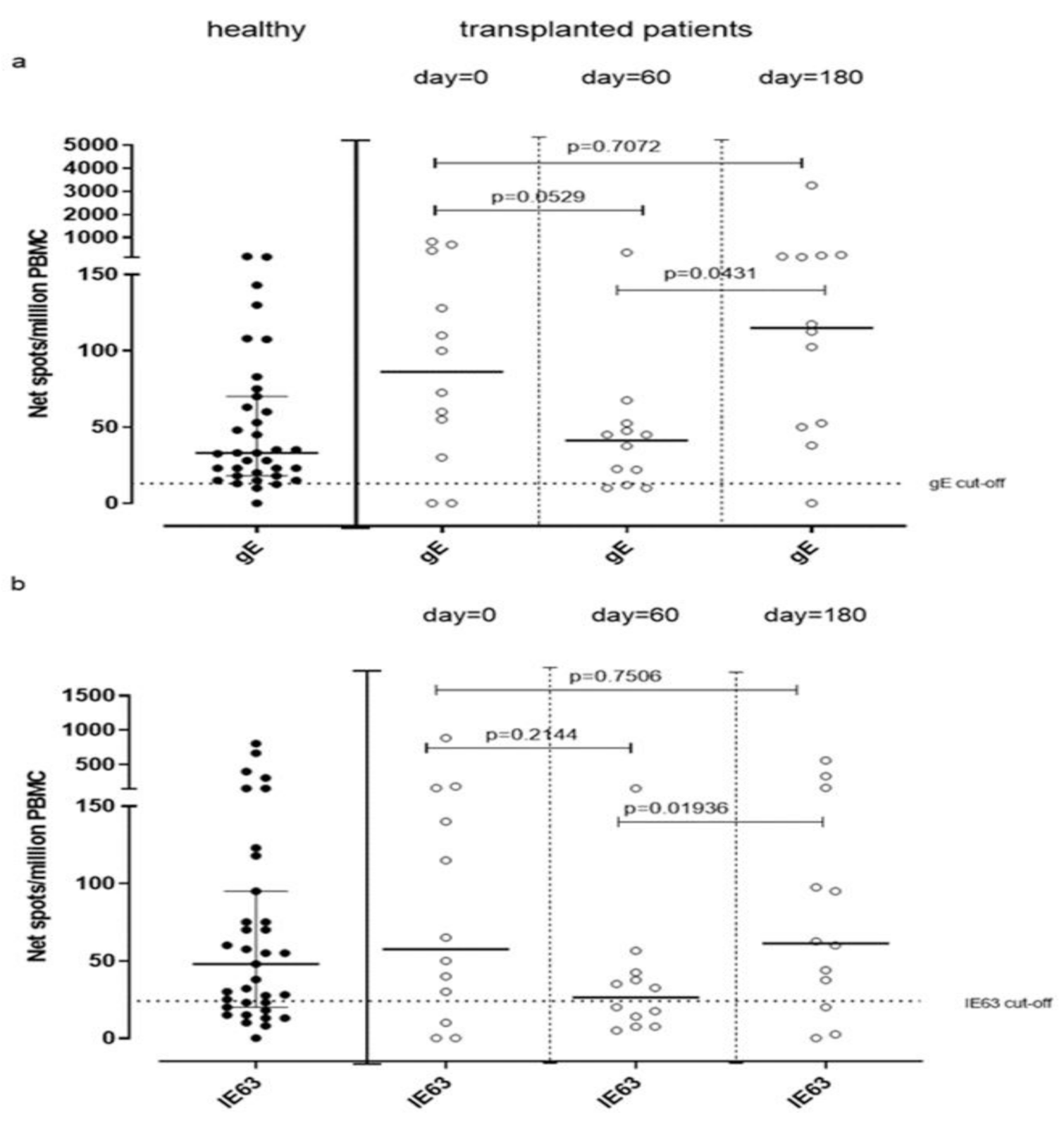Characterization of Varicella-Zoster (VZV) Specific T Cell Response in Healthy Subjects and Transplanted Patients by Using Enzyme Linked Immunospot (ELISpot) Assays
Abstract
:1. Introduction
2. Materials and Methods
2.1. Subjects Enrolled
2.2. Isolation of Peripheral Blood Mononuclear Cells
2.3. Antibody Titer
2.4. Synthetic Peptides and ELISpot Assay
2.5. Intracellular Cytokine Staining (ICS)
2.6. Data Analysis
3. Results
3.1. gE and IE63-Specific T-Cell Response Measure by Ex Vivo ELISpot Assay in Healthy Subjects
3.2. gE and IE63-Specific T-Cell Response Measure by Cultured ELISpot Assayin Healthy Subjects
3.3. Correlation of Humoral and T-Effector Memory and T-Central Memory Response against VZV in VZV-Seropositive Healthy Subjects
3.4. Phenotypical Characterization of VZV-Specific T-Cell Response Measured by Ex Vivo ELISpot Assay in Healthy Subjects
3.5. Evaluation of VZV-Specific T-Cell Response in Transplanted Subjects by Using Both Ex Vivo and Cultured ELISpot Assays
4. Discussion
5. Conclusions
Author Contributions
Funding
Institutional Review Board Statement
Informed Consent Statement
Acknowledgments
Conflicts of Interest
References
- Rondaan, C.; de Haan, A.; Horst, G.; Hempel, J.C.; van Leer, C.; Bos, N.A.; van Assen, S.; Bijl, M.; Westra, J. Altered cellular and humoral immunity to varicella-zoster virus in patients with autoimmune diseases. Arthritis Rheumatol. 2014, 66, 3122–3128. [Google Scholar] [CrossRef] [PubMed]
- De Castro, N.; Carmagnat, M.; Kerneis, S.; Scieux, C.; Rabian, C.; Molina, J.M. Varicella-zoster virus-specific cell-mediated immune responses in HIV-infected adults. AIDS Res. Hum. Retrovir. 2011, 27, 1089–1097. [Google Scholar] [CrossRef]
- Okamoto, S.; Hata, A.; Sadaoka, K.; Yamanishi, K.; Mori, Y. Comparison of varicella-zoster virus specific immunity of patients with diabetes mellitus and healthy individuals. J. Infect. Dis. 2009, 200, 1606–1610. [Google Scholar] [CrossRef] [PubMed] [Green Version]
- Arness, T.; Pedersen, R.; Dierkhising, R.; Kremers, W.; Patel, R. Varicella zoster virus-associated disease in adult kidney transplant recipients: Incidence and risk-factor analysis. Transpl. Infect. Dis. 2008, 10, 260–268. [Google Scholar] [CrossRef] [PubMed]
- Ellis, D.L.; Barsell, A.; Riahi, R.R.; Stumpf, B. Varicella zoster virus encephalitis in a patient with disseminated herpes zoster: Report and review of the literature. Dermatol. Online J. 2015, 21, 16. [Google Scholar] [CrossRef]
- Galetta, K.M.; Gilden, D. Zeroing in on zoster: A tale of many disorders produced by one virus. J. Neurol. Sci. 2015, 358, 38–45. [Google Scholar] [CrossRef] [PubMed] [Green Version]
- Gershon, A.A.; Gershon, M.D. Pathogenesis and current approaches to control of varicella-zoster virus infections. Clin. Microbiol. Rev. 2013, 26, 728–743. [Google Scholar] [CrossRef] [PubMed] [Green Version]
- Gershon, A.A.; Gershon, M.D. The Jeremiah Metzger lecture varicella zoster virus: From outside to inside. Trans. Am. Clin. Climatol. Assoc. 2016, 127, 282–299. [Google Scholar] [PubMed]
- Moffat, J.; Ku, C.C.; Zerboni, L.; Sommer, M.; Arvin, A. VZV: Pathogenesis and the disease consequences of primary infection. In Human Herpesviruses: Biology, Therapy, and Immunoprophylaxis; Cambridge University Press: Cambridge, UK, 2007; Volume 37. [Google Scholar]
- Ouwendijk, W.J.; Verjans, G.M. Pathogenesis of varicelloviruses in primates. J. Pathol. 2005, 235, 298–311. [Google Scholar] [CrossRef] [PubMed] [Green Version]
- Roderick, M.; Finn, A.; Ramanan, A.V. Chickenpox in the immunocompromised child. Arch. Dis. Child. 2012, 97, 587–589. [Google Scholar] [CrossRef]
- Arvin, A.M.; Sharp, M.; Smith, S.; Koropchak, C.M.; Diaz, P.S.; Kinchington, P.; Ruyechan, W.; Hay, J. Equivalent recognition of a varicella-zoster virus immediate early protein (IE62) and glycoprotein I by cytotoxic T lymphocytes of either CD4+ or CD8+ phenotype. J. Immunol. 1991, 146, 257–264. [Google Scholar] [PubMed]
- Calarota, S.A.; Baldanti, F. Enumeration and characterization of human memory T cells by Enzime-Linked Immunospot Assays. Clin. Dev. Immunol. 2013, 2013, 637–649. [Google Scholar] [CrossRef] [Green Version]
- Sallusto, F.; Lenig, D.; Förster, R.; Lipp, M.; Lanzavecchia, A. Two subsets of memory T lymphocytes with distinct homing potentials and effector function. Nature 1999, 401, 708–712. [Google Scholar] [CrossRef]
- Esser, M.T.; Marchese, R.D.; Kierstead, L.S.; Tussey, L.G.; Wang, F.; Chirmule, N.; Washabaugh, M.W. Memory T cells and vaccines. Vaccine 2003, 21, 419–430. [Google Scholar] [CrossRef]
- Crespo, J.F.; Gorriz, J.L.; Avila, A.; Sancho, A.; Gavela, E.; Cano, A.; Zanon, V.; Pallardó, L.M. Prevalence of past varicella zoster virus infection in candidates for kidney transplantation: Vaccination in seronegative patients. Transplant. Proc. 2002, 34, 77. [Google Scholar] [CrossRef]
- Geel, A.L.; Landman, T.S.; Kal, J.A.; van Doomum, G.J.; Weimar, W. Varicella zoster virus serostatus before and after kidney transplantation, and vaccination of adult kidney transplant candidates. Transplant. Proc. 2006, 38, 3418–3419. [Google Scholar] [CrossRef]
- Arvin, A.M. Humoral and cellular immunity to varicella-zoster virus: An overview. J. Infect. Dis. 2008, 197, S58–S60. [Google Scholar] [CrossRef] [PubMed] [Green Version]
- Cassaniti, I.; Calarota, S.A.; Adzasehoun, M.G.K.; Chiesa, A.; Comolli, G.; Parea, M.; Baldanti, F. Memory T cells specific for HBV enumerated by a peptide-based cultured enzyme-linked immunospot assay in healthy HBV-vaccinated subjects. Hum. Vaccin. Immunother. 2016, 12, 2927–2933. [Google Scholar] [CrossRef] [PubMed] [Green Version]
- Levin, M.J.; Smith, J.G.; Kaufhold, R.M.; Barber, D.; Hayward, A.R.; Chan, C.Y.; Chan, I.S.; Li, D.J.; Wang, W.; Keller, P.M.; et al. Decline in varicella-zoster virus (VZV)-specific cell-mediated immunity with increasing age and boosting with a high-dose VZV vaccine. J. Infect. Dis. 2003, 188, 1336–1344. [Google Scholar] [CrossRef] [PubMed] [Green Version]
- Duncan, C.J.; Hambleton, S. Varicella zoster virus immunity: A primer. J. Infect. 2015, 71, S47–S53. [Google Scholar] [CrossRef]
- Rondaan, C.; de Joode, A.A.E.; van Assen, S.; Bos, N.A.; Westerhuis, R.; Westra, J. Increased incidence of herpes zoster in patients on renal replacement T-therapy cannot be explained by intrinsic defects of cellular or humoral immunity to varicella-zoster virus. Antivir. Res. 2018, 158, 206–212. [Google Scholar] [CrossRef] [PubMed] [Green Version]
- Lehmann, P.V.; Zhang, W. Unique strengths of ELISPOT for T cell diagnostics. Methods Mol. Biol. 2012, 792, 3–23. [Google Scholar] [PubMed]
- Karlsson, A.C.; Martin, J.N.; Younger, S.R.; Bredt, B.M.; Epling, L.; Ronquillo, R.; Varma, A.; Deeks, S.G.; McCune, J.M.; Nixon, D.F.; et al. Comparison of the ELISPOT and cytokine flow cytometry assays for the enumeration of antigen-specific T cells. J. Immunol. Methods 2003, 283, 141–153. [Google Scholar] [CrossRef] [PubMed]
- Betjes, M.G. Immune cell dysfunction and inflammation in end-stage renal disease. Nat. Rev. Nephrol. 2013, 9, 255–265. [Google Scholar] [CrossRef]
- Kato, S.; Chmielewski, M.; Honda, H.; Pecoits-Filho, R.; Matsuo, S.; Yuzawa, Y.; Tranaeus, A.; Stenvinkel, P.; Lindholm, B. Aspects of immune dysfunction in end stage renal disease. Clin. J. Am. Soc. Nephrol. 2008, 3, 1526–1533. [Google Scholar] [CrossRef] [Green Version]
- Fishman, J.A. Infection in Organ Transplantation. Am. J. Transplant. 2017, 17, 856–879. [Google Scholar] [CrossRef] [Green Version]
- Smetana, Z.; Leventon-Kriss, S.; Broide, A.; Smetana, S.S. Varicella-zoster virus immune status in CAPD and chronic hemodialysis patients. Am. J. Nephrol. 1991, 11, 229–236. [Google Scholar] [CrossRef] [PubMed]





Publisher’s Note: MDPI stays neutral with regard to jurisdictional claims in published maps and institutional affiliations. |
© 2021 by the authors. Licensee MDPI, Basel, Switzerland. This article is an open access article distributed under the terms and conditions of the Creative Commons Attribution (CC BY) license (https://creativecommons.org/licenses/by/4.0/).
Share and Cite
Cassaniti, I.; Ferrari, A.; Comolli, G.; Sarasini, A.; Gregorini, M.; Rampino, T.; Lilleri, D.; Baldanti, F. Characterization of Varicella-Zoster (VZV) Specific T Cell Response in Healthy Subjects and Transplanted Patients by Using Enzyme Linked Immunospot (ELISpot) Assays. Vaccines 2021, 9, 875. https://doi.org/10.3390/vaccines9080875
Cassaniti I, Ferrari A, Comolli G, Sarasini A, Gregorini M, Rampino T, Lilleri D, Baldanti F. Characterization of Varicella-Zoster (VZV) Specific T Cell Response in Healthy Subjects and Transplanted Patients by Using Enzyme Linked Immunospot (ELISpot) Assays. Vaccines. 2021; 9(8):875. https://doi.org/10.3390/vaccines9080875
Chicago/Turabian StyleCassaniti, Irene, Alessandro Ferrari, Giuditta Comolli, Antonella Sarasini, Marilena Gregorini, Teresa Rampino, Daniele Lilleri, and Fausto Baldanti. 2021. "Characterization of Varicella-Zoster (VZV) Specific T Cell Response in Healthy Subjects and Transplanted Patients by Using Enzyme Linked Immunospot (ELISpot) Assays" Vaccines 9, no. 8: 875. https://doi.org/10.3390/vaccines9080875





